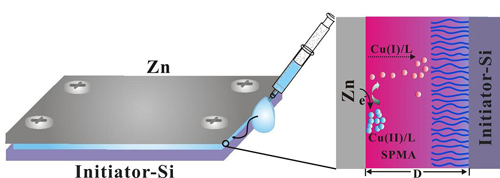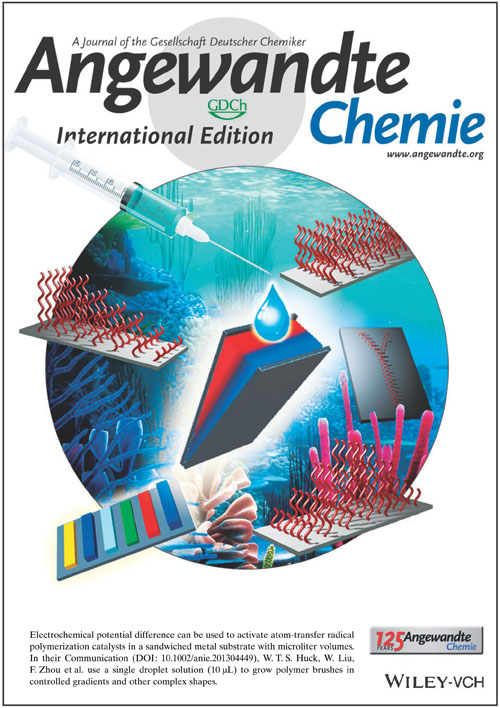Among different surface-polymerization strategies, surface-initiated atom-transfer radical polymerization (SI-ATRP) is one of the most versatile and widely used routes to prepare well-defined polymer brushes. However, there are still many shortcomings concerning this method, namely the use of inert atmosphere to protect the reactions, waste of large amount of monomer solution, poor controllability of the growth of polymer chain.
In cooperation with Radboud University Nijmegen in Poland and the Hong Kong Polytechnic University, the research group for surface/interface of materials at State Key Laboratory of Solid Lubrication of Lanzhou Institute of Chemical Physics of the Chinese Academy of Sciences (LICP), has exploited the electrochemical potential difference between reductive metals and a CuII/L solution to generate a CuI/L catalyst that initiates surface-bound ATRP. This method allows polymer-brush growth in a metal-substrate sandwiched architecture in air, using volumes as small as 5?μL, in which CuI activators are continuously generated and diffusively transported to the initiator-modified substrate. Polymer-brush gradients and complex shapes were easily generated by spatially distributing the generation of the catalyst.
The advantage of this approach is that polymerizations of minute quantities of multiple monomers on a single surface can easily be achieved and many polymer brushes can be formed simultaneously using sa-ATRP. This method shows potential for applications involving expensive or hard-to-synthesize monomers and in screening the properties of many (co-)polymer brushes simultaneously.
The work has been published in Angew. Chem. Int. Ed.(2013, DOI: 10.1002 /anie.201304449) and Adv. Mater.(2013,25,3343-3450). The paper published in Angew. Chem. Int. Ed. was spoken highly by the editors of the journal and they thought that “This is a very innovative way to produce gradient polymer brushes on the macroscopic scale. Really nice work and surely of general significance for a broad readership. Publish as is!!” The paper was selected as the hot paper and inside-cover paper of the journal.
In addition, they have developed a light-modulated surface-initiated ATRP. TiO2 is a kind of excellent semi-conducting materials and can generate electron and empty hole. They have used TiO2 nanoparticles as photoactive materials to reduce Cu(II)/L to a Cu(I)/L complex under UV irradiation by a one-electron transfer process for ATRP with multiple usage of monomer solutions. The growth of polymer brushes can be manipulated by either varying the content of photoactive materials or regulating the irradiation intensity, thereby yielding polymer brushes with controllable thickness, composition, and architecture. The work has been published in ACS Macro Lett. (2013,2,592-596) and the paper is among the top 5 most read paper July.
The work has received support from the General Program of National Natural Science Foundation of China, National Science Foundation for Distinguished Young Scholars, Key Program of the Chinese Academy of Sciences and the National Program on Key Basic Research Project of China (973 Program).

SI-ATRP on a sandwiched metal substrate using microliter volumes. (Image by ZHOU Feng et al.)

Schematic illustration of UV Light-Induced ATRP(Image by ZHOU Feng et al.)

Inside back cover of Angew. Chem.


